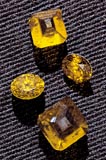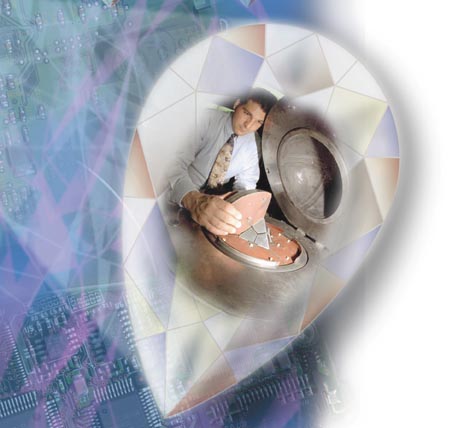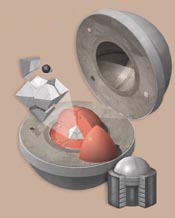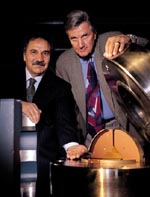Synthetic Gemstones Have Aesthetic, Electronic Potential
By Aaron Hoover
 A scientist and engineer, Reza Abbaschian
is trained to be skeptical. So when he went to Russia in 1997 with an American
entrepreneur to investigate claims of a machine that could make diamonds,
he was worried the two might be the dupes in an elaborate con.
A scientist and engineer, Reza Abbaschian
is trained to be skeptical. So when he went to Russia in 1997 with an American
entrepreneur to investigate claims of a machine that could make diamonds,
he was worried the two might be the dupes in an elaborate con.
At a Moscow warehouse, Abbaschian and Carter Clarke, a retired U.S. Army general, watched closely as a scientist and a handful of technicians assembled the machine to ensure no one slipped a diamond inside. It was a rainy, cold November day and there was no heat, but neither Clarke nor Abbaschian wanted to let the machine out of their sight during the six-hour manufacturing process. With temperatures in the low 40s, they stood around a tiny portable heater shivering and waiting.
 Now,
as Abbaschian watched a technician open the machine, he pondered his doubts.
Now,
as Abbaschian watched a technician open the machine, he pondered his doubts.
The chairman of the University of Florida Department of Materials Science and Engineering and an expert in crystal growth, he knew the only other machines capable of producing diamonds were room-sized and expensive. Yet the machine in the warehouse was no larger than a washing machine and made of inexpensive, off-the-shelf materials. Adding to Abbaschian’s skepticism was the knowledge that two similar machines had twice failed to make anything resembling a diamond days earlier in St. Petersburg, where the Americans had stopped first after the 5,500-mile flight from Florida. "I thought the whole thing was a hoax," Abbaschian recalls.
A technician opened the halves of a basketball-sized sphere within the machine and began pulling out small steel anvils, finally removing a ceramic block the size of a sugar cube. He cracked the block in two with a hammer, then put its contents under a microscope. Abbaschian leaned over and peered through the lens. The tiny object glittering inside the cream-colored ceramic was unmistakable, and he felt a wave of surprise and excitement.
"There was a small diamond," Abbaschian says. "That made me a little more comfortable that the technology worked, at least one time anyway."
A little more than two years after that encounter, Abbaschian heads up a major research effort centered around the machines — not in Moscow, but on the UF campus. The research, which involves several UF engineers and three Russian researchers, has two thrusts.
One is to make the machines produce gem-quality diamonds with the quality and consistency required for the jewelry market. Gemesis Corp, a company headed by Clarke in which the UF Research Foundation holds an interest, is paying for this effort, which so far has resulted in 360 crystals and diamonds as large as 1.6 carats. With positive initial results, Gemesis launched production at an off-campus facility in Gainesville in December.
The other thrust is more theoretical but of greater potential reach. Seeking to create a new breed of powerful, durable electronics, UF researchers want to use the machines to turn diamonds into semiconductors — and to manufacture a rare and much sought-after semiconductor material called gallium nitride. If successful, UF and Gemesis both stand to gain tremendously.
"Diamonds are one of the most exotic
materials in the world in terms of electronic applications," says Rajiv
Singh, a professor of materials science and engineering and the lead investigator
in this area. "If you could make electronic devices from diamonds like
you make from silicon, they could be orders of magnitude hardier and better." 
From Missiles to Rings
The machines’ capabilities are matched only by their mysterious origin. Clarke, a 1948 West Point graduate whose booming voice and rock-hard handshake reflect his 26 years as an Army infantry commander, says he first learned of them while visiting Russia in 1996 on an unrelated business venture. As chief executive officer of a St. Petersburg business that specialized in electronic security products, Clarke was looking for technology to make magnetic ink to deter the theft of sensitive documents. A Moscow contact asked if he’d be interested in looking into another opportunity: diamonds.
What Clarke learned astonished him. In the early 1980s, Russian scientists developed small machines to make diamonds for military purposes in an unnamed, closed city near the Siberian city of Novosibirsk. Although the military’s plans for the manufactured diamonds is somewhat sketchy, at least one goal was to use them as hardened windows for guidance lasers in cruise missiles. The technology was kept secret through the breakup of the Soviet Union in 1991 but was in the hands of private investors at the time of Clarke’s visit.
Clarke bought three of the machines, then returned to the United States. A recommendation from a friend and a story on CNN about an industrial diamond manufactured at UF prompted him to contact Abbaschian. After hearing Clarke’s story, Abbaschian agreed to accompany him on a trip to Russia. They examined the machines and diamonds purportedly made with them, but it wasn’t until a second trip that they viewed the Moscow demonstration.
Although Abbaschian only glimpsed the technology, he realized one of the Russian scientists’ great insights could be summarized in a single word: geometry. Natural diamonds form from carbon miles under the ground, the result of a combination of intense heat and pressure. Scientists in the United States and elsewhere had been able to reproduce these conditions in the lab since as early as the 1950s, but it required machines with presses weighing as much as 1,000 tons. The two-ton Russian machine, by contrast, relied on an oyster-shell-like growth chamber containing a series of hardened-steel dies arranged in a sphere. Pressure applied to the outside of the sphere magnifies through the dies, building to an almost unimaginable force of 850,000 pounds per square inch at the core of the sphere. By comparison, the pressure generated by the lifting arm in a loaded dump truck might reach 10,000 pounds per square inch.
What was clear from Abbaschian and Clarke’s Moscow trip, however, was that the process needed considerable refinement. Although Clarke’s first impulse was to improve the machine’s performance in Russia, he realized the country’s perilous economic conditions would make the enterprise a hard sell with potential investors. As a result, he and Abbaschian decided to import the three machines to the UF Department of Materials Science and Engineering.
‘The Mikimoto of Diamonds’
The first two machines arrived in early 1998, with three more to follow. For Abbaschian, the challenge from the start has been clear cut: turn a nifty but unreliable experiment into an industrial process that makes manufacturing diamonds, the hardest and one of the most precious substances on Earth, as reliable as manufacturing tires or paper towels.
"It involves doing the same things over and over under controlled conditions," Abbaschian says. "It also involves understanding the fundamentals, the basic principles — what is happening in the process and what kind of parameters one can change to improve the quality, growth rate and color."
The variables are daunting. The American and Russian researchers at UF have tinkered with the ingredients of the core where the diamond is formed, how the ingredients are arranged in sequence and the temperature during the process. Their goal: to learn how to eliminate or control impurities, which turn the manufactured diamonds different colors. In nature, colored diamonds are rare, but the machine-made diamonds tend to come out yellow and amber because of the intrusion of nitrogen impurities. Abbaschian is slowly learning how to make others colors and colorless diamonds.
"For amber or yellow diamonds, we have the process more or less under control for about 1.5 to 1.6 carats," he says. "For greenish and bluish color, we have the process under control for a half carat to one carat. So we’re at different stages for different diamonds."
The efforts are tied directly to Gemesis Corp.’s marketing plans. Far from attempting to pass them off as natural, Clarke plans to sell the gems as "cultured diamonds" similar to cultured pearls. Whatever color the market demands, Gemesis plans to produce and sell at well below the market price for natural stones. Skeptics may scoff, but Clarke says he is confident the diamonds will fly off the black velvet. Given the choice between a four-carat manufactured diamond and a two-carat natural one for the same price, he says, most women don’t hesitate.
"If everything is equal about the diamonds — the size, the shape, the color, the quality, the consistency, the hardness, the refractive index, the sparkle, the brilliance — I have yet to have anybody tell me they’d take the two," Clarke says.
The test of Clarke’s optimism will come soon enough. In October, an Ocala foundry delivered the first diamond machine built in the United States for Gemesis. The company plans to operate 72 machines in a rented 10,000-square-foot facility at a Gainesville industrial park. With about $2 million already invested in the enterprise from a handful of private investors, he recently began seeking $10 million in additional backing for up to 200 more machines. Clarke’s goal: to begin selling 3/4- to 1-carat finished diamonds this year while continuing to refine and speed up the process.
"We’re going to be the Mikimoto of diamonds," Clarke promises, referring to the giant Japanese cultured pearl company.
M. Jack Ohanian, interim dean of the College of Engineering, says UF’s collaboration with Gemesis is a good example of the kind of university-industry partnerships UF strives to foster.
"We’re helping this company perfect this unique and wonderful technology, but that’s not all," he says. "We’re also broadening our scientific understanding of crystal growth and helping to create industry and jobs in the Gainesville community."
Besides, UF researchers are hoping for an even bigger score: They’d like to use the machines as the driving force behind a new breed of electronics for the next millennium.
Gainesville: Diamond Valley
 Cheap,
abundant and easily manufactured, silicon has dominated the semiconductor
industry since its inception. But the material has a serious flaw: Excessive
temperatures or power causes silicon components to malfunction or even
melt. This quality restricts its usefulness for technologies thought to
be crucial in the coming century, including electric- or fuel cell-powered
cars, high-speed trains and high-quality power distribution systems. Without
significant protection, silicon also can’t survive the hostile environments
of nuclear war or outer space.
Cheap,
abundant and easily manufactured, silicon has dominated the semiconductor
industry since its inception. But the material has a serious flaw: Excessive
temperatures or power causes silicon components to malfunction or even
melt. This quality restricts its usefulness for technologies thought to
be crucial in the coming century, including electric- or fuel cell-powered
cars, high-speed trains and high-quality power distribution systems. Without
significant protection, silicon also can’t survive the hostile environments
of nuclear war or outer space.
Diamonds, by contrast, are far tougher. Only rarely, however, do natural diamonds contain the trace elements needed to make them effective as semiconductors. UF researchers hope to use the Russian machines to figure out how to implant the elements needed to make semiconducting diamonds.
(Reza Abbaschian (left), chair of UF's Department of Materials Science and Engineering, is interested in the potential of synthetic diamonds as semiconductors. Carter Clarke, president of Gemesis Corp., hopes they can compete with natural diamonds in jewelry.)
"What we have to do is grow the diamonds so that we incorporate the desired atoms uniformly throughout the crystal, so when we cut it into wafers it has the proper structure and electronic properties," says Robert Chodelka, a UF research faculty member in materials science.
UF researchers are also probing the usefulness of the machines for making gallium nitride, another rare semiconductor that could be key to more powerful computers and communications. Gallium nitride can produce blue lasers, which have shorter wavelengths than common red lasers and thus can significantly boost the storage capacity for CD-ROMS and hard drives.
The commercial potential for either one of these technologies far exceeds the potential gemstones. Singh, the materials science and engineering professor in charge of the electronics work, says the market for high-power, high-temperature electronics alone is $10 billion annually. If UF can be the source of pioneering technology in this area, the sky is the limit.
"Everybody knows about Silicon Valley," Abbaschian says. "We’d like to make Gainesville the ‘Diamond Valley’ of the electronics industry in the next century."
Reza Abbaschian
Chairman and Professor, Department
of Materials Science and Engineering
(352) 846-3301
rabba@mse.ufl.edu
Related web site:
http://www.mse.ufl.edu